| F2G "Super" Corsair | |
|---|---|
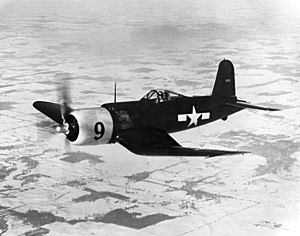 XF2G-1 XF2G-1 | |
| General information | |
| Type | Carrier-based fighter aircraft |
| Manufacturer | Goodyear Aircraft |
| Primary user | United States Navy |
| Number built | 10 + 7 prototypes |
| History | |
| Manufactured | 1945 |
| Introduction date | 1945 |
| First flight | 15 July 1945 |
| Retired | 1945 |
| Developed from | Vought F4U Corsair |
The Goodyear F2G Corsair, often referred to as the "Super Corsair", is a development by the Goodyear Aircraft Company of the Vought F4U Corsair fighter aircraft. The F2G was intended as a low-altitude interceptor and was equipped with a 28-cylinder, four-row Pratt & Whitney R-4360 air-cooled radial engine.
Such a fighter was first conceived in 1939, when Pratt & Whitney first proposed the immense, 3,000 hp (2,200 kW) R-4360, and design work began in early 1944.
Design and development
| This section needs additional citations for verification. Please help improve this article by adding citations to reliable sources in this section. Unsourced material may be challenged and removed. Find sources: "Goodyear F2G Corsair" – news · newspapers · books · scholar · JSTOR (May 2024) (Learn how and when to remove this message) |
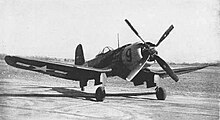
Using experience gained building the F4U-1 under license – a variant known as the FG-1 – in early 1944, Goodyear modified seven standard Corsair airframes to take advantage of the 50% increase in take-off power provided by the Pratt and Whitney R-4360 engine. Known as the XF2G-1, these aircraft also featured a new all-round vision bubble-type canopy in place of the original cockpit and turtle deck.
A land-based variant, with manually-folding wings, was to be known as the F2G-1, while a carrier version with hydraulically-folding wings and arrestor hook was to be called the F2G-2. In March 1944, Goodyear was awarded a contract to deliver 418 F2G-1 and 10 F2G-2 aircraft. The vertical stabilizer's height was also increased by 12 inches, and an auxiliary rudder was added to counteract engine torque. With all these design modifications, the rate of climb of the F2G was increased to 7,000 feet per minute, which was double that of a standard Corsair and higher than jet fighters in service at that time.
The aircraft was intended to be operated from land bases as opposed to aircraft carriers. The F2G-1 had manually folding wings and no tail hook, allowing for reduced weight. The F2G-2 had hydraulically powered wing fold mechanisms and tail hooks installed to allow for carrier operations.
Armament was to include four or six wing-mounted 0.5-inch (12.7 mm) machine guns and eight 5-inch (127 mm) rockets or two 1,000lbs (454kg) Mk.83 GP bombs or 1,600lbs (725kg) AN-Mk.1 armor piercing bombs. The internal fuel capacity of the F2G was increased greatly over that of the F4U, and provisions were also made for two droptanks.
However, post-production testing revealed deficiencies in lateral control and insufficient speed, which were bars to further development of the design. In addition, the Grumman F8F Bearcat – a rival design that had also entered production – had performance comparable to the F2G, even though it was powered with the same engine as the original F4U. By the end of the war in August 1945, when only 10 aircraft (five examples of each variant) had been completed, further production of the F2G was canceled.
Variants
XF2G-1: prototype. Seven converted from standard FG-1 Corsairs.
F2G-1: land-based variant, 418 ordered, five built, order cancelled.
F2G-2: carrier-based variant, 10 ordered, five built, order cancelled.
Operators
Accidents and incidents
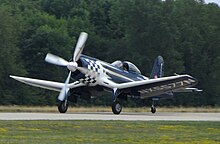
On 7 September 2012, the heavily modified F2G-2 "Race 74", BuNo 88463 and registered N5577N, was destroyed in a fatal crash that occurred when pilot Bob Odegaard was rehearsing for an airshow flight routine at the Barnes County Municipal Airport in Valley City, North Dakota.
Surviving aircraft

Two Super Corsairs have survived into preservation, with one airworthy.
- Airworthy (F2G-1)
- 88458 (better known as "Race 57"): privately owned in Bentonville, Arkansas. It was the fifth production aircraft and was purchased by Cook Cleland, who went on to finish first in the 1947 Thompson Trophy Race and first in the 1949 Tinnerman Trophy Race. Over time, the aircraft, registered as NX5588N, went from owner to owner and slowly deteriorated. Finally, in 1996, NX5588N was purchased by Bob Odegaard of North Dakota, and was returned to airworthy condition in 1999. The aircraft was on loan to the Fargo Air Museum. Odegaard raced the aircraft in the Unlimited class at the Reno Air Races from 2006 to 2008 and it was featured in the movie Thunder Over Reno. The aircraft was bought in February, 2017 by Steuart Walton. It is based at Louise M. Thaden Airfield in Bentonville, Arkansas.
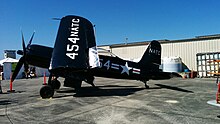
- On display (F2G-1)
- 88454: Museum of Flight in Seattle, Washington. It was the first production aircraft and was acquired from the Marine Corps by the Champlin Fighter Museum, and later came to the Museum of Flight in Seattle with the rest of the Champlin collection.
Specifications (F2G-2)
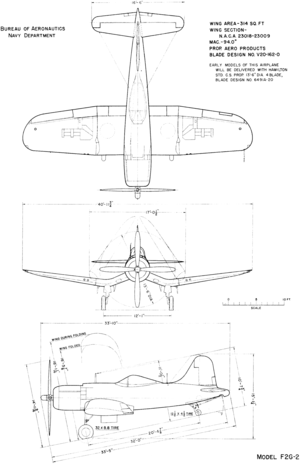
Data from
General characteristics
- Crew: 1
- Length: 33 ft 9 in (10.3 m)
- Wingspan: 41 ft 0 in (12.5 m)
- Height: 16 ft 1 in (4.9 m)
- Wing area: 314 sq ft (29 m)
- Empty weight: 10,249 lb (4,649 kg)
- Gross weight: 13,346 lb (6,054 kg)
- Max takeoff weight: 15,422 lb (6,995 kg)
- Powerplant: 1 × Pratt & Whitney R-4360-4 "Wasp Major" 28-cylinder radial engine, 3000 hp (2200 kW)
Performance
- Maximum speed: 431 mph (694 km/h, 374 kn) at 16,400 ft (5,000 m)
- Range: 1,955 mi (3,146 km, 1,699 nmi) with external tanks
- Service ceiling: 38,800 ft (11,800 m)
- Rate of climb: 4,400 ft/min (22.35 m/s)
- Wing loading: 42.5 lb/sq ft (208 kg/m)
- Power/mass: 0.22 hp/lb (370 W/kg)
Armament
- Guns: 4× .50 caliber (12.7 mm) M2 Browning machine guns, 400 rounds/gun
- Rockets: 8× 5 in (127 mm) rockets or
- Bombs: 1,600 lb (725 kg)
See also
Related development
Aircraft of comparable role, configuration, and era
- CAC CA-15
- Curtiss XP-62
- Grumman F8F Bearcat
- Hawker Sea Fury
- Kawasaki Ki-100
- Lavochkin La-9
- Martin-Baker MB5
- Republic XP-72
- Supermarine Spiteful
Related lists
- List of fighter aircraft
- List of United States Navy aircraft designations (pre-1962)
- List of military aircraft of the United States
References
Notes
- This designation was used twice; the first XF2G-1 was a 1928 Eberhart prototype.
- Some sources state that there were eight XF2G-1 prototypes, with the FG-1A BuNo 12992 being modified in addition to the other seven. However, 12992 was used as a static test airframe for the program and never received the XF2G designation.
Citations
- Pautigny 2003, p. 76.
- ^ Veronico, Nicholas A.; Campbell, John A.; Campbell, Donna (1994). Warbird History: F4U Corsair. Motorbooks International. pp. 75–76. ISBN 0-87938-854-4.
- Dorr 1991, p.68.
- "Air-and-Space.com: Corsairs with Four-bank Radials". www.air-and-space.com. Retrieved 2024-05-16.
- Goyer, Robert. "Bob Odegaard killed in crash of Super Corsair". Flying, 8 September 2012.
- "Famed N.D. pilot Bob Odegaard killed during practice for Valley City air show". Grand Forks Herald. Sep 7, 2012. Retrieved 19 March 2016.
- "FAA Registry: N5588N" FAA.gov. Retrieved: 15 July 2021.
- "Goodyear F2G-1D Super Corsair Race #57." Archived 2012-09-11 at the Wayback Machine Duggy.com. Retrieved: 8 September 2012.
- "Race results database" Archived 2008-09-19 at the Wayback Machine. Reno Air Racing Association, 24 September 2008. Retrieved: 12 June 2010.
- "Hardware." Archived 2016-03-05 at the Wayback Machine Thunder over Reno. Retrieved: 31 December 2011.
- "F2G-1 Corsair/Bu. 88454." Museum of Flight. Retrieved: 31 December 2011.
- "FAA Registry: N4324." FAA.gov Retrieved: 15 July 2021.
Bibliography
- Dorr, Robert F. US Fighters of World War Two. London, UK, Arms and Armour Press, 1991. ISBN 1-85409-073-9
- Lockett, Brian. "Corsairs with Four-bank Radials". Goleta Air and Space Museum. Retrieved: 16 January 2007.
- Pautigny, Bruno (translated from the French by Alan McKay). Corsair: 30 Years of Filibustering 1940-1970. Paris: Histoire & Collections, 2003. ISBN 2-913903-28-2.
- "Racing Corsairs." Society of Air Racing Historians. Retrieved: 16 January 2007.
External links
- F2G-1 Corsair on display at the Museum of Flight in Seattle
- F2G-1D Corsair in flying condition at Odegaard Aviation
| Goodyear aircraft | |||||
|---|---|---|---|---|---|
| Lighter-than-air |
| ||||
| Heavier-than-air |
| ||||
| United States Navy fighter designations pre-1962 | |
|---|---|
| General Aviation Brewster | |
| Boeing | |
| Curtiss | |
| Douglas McDonnell | |
| Grumman | |
| Eberhart Goodyear | |
| Hall McDonnell | |
| Berliner-Joyce North American | |
| Loening Bell | |
| General Motors | |
| Naval Aircraft Factory | |
| Lockheed | |
| Ryan | |
| Supermarine | |
| Northrop | |
| Vought | |
| Canadian Vickers Lockheed | |
| Wright CC&F |
|
| Convair | |
| Not assigned • Assigned to a different manufacturer's type See also: Aeromarine AS • Vought VE-7 | |